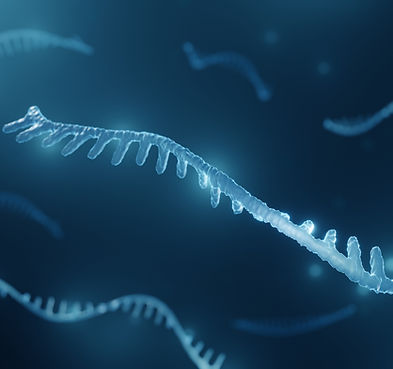Highlights:
Issue 8 - August 2025
Issue 5 Article 7
Tiny Molecules, Big Impact: How microRNAs Changed Genetics
25/5/20
By:
Govindan Ajitesh
Edited:
Elijah Chew Ze Feng
Tag:
Molecular Biology and Biochemistry

In 2024, the Nobel Prize in Physiology or Medicine went to Victor Ambros and Gary Ruvkun, not for discovering a new gene, but for revealing a hidden layer of genetic control mechanisms. Typical gene regulation mechanisms involve activators and repressors, proteins encoded by mRNA that bind to specific DNA sites to inhibit transcription. But what they found were microRNAs: tiny bits of ribonucleic acid that don’t make proteins, but quietly influence which genes are switched on and off. It was a breakthrough that turned the genetic rulebook on its head.
The Worm That Sparked a Revolution
Back in the early 1990s, Ambros and Ruvkun were studying a microscopic worm called C. elegans. It’s a go-to model in genetics: simple, well-mapped, and only 959 cells when fully grown. Both had trained in the lab of Robert Horvitz, a future Nobel winner himself.
Ambros was looking at an odd gene called lin-4. Mutations in it affected the timing of the worm’s development. When Ambros isolated lin-4, he found something unexpected: it wasn’t a protein-coding gene. Instead, lin-4 made a tiny RNA molecule, just 22 nucleotides long. At the time, RNAs were mostly thought of as messengers between DNA and proteins. This wasn’t anything like that.
Meanwhile, Ruvkun was working on a different gene, lin-14. He noticed that in some mutants, the amount of LIN-14 protein was very high even though the mRNA levels were normal, implying some post-transcriptional regulation was at play here.
The connection? That little lin-4 RNA. It was binding to the 3’ untranslated region (3’ UTR) of lin-14 mRNA. Not destroying it, just blocking its translation. In some mutants, the binding site was no longer complementary, and lin-14 ran unchecked. This was a brand-new method of gene regulation: genes being silenced after transcription without being deleted or mutated.
Then Came let-7: This Wasn’t Just a Worm Thing
At first, scientists thought this might be unique to worms. But in 2000, Ruvkun’s lab found another small RNA, let-7, doing something similar. And this time, it wasn’t unique to worms. It showed up in fruit flies. Zebrafish. Even humans. That changed everything.
Suddenly, it was clear: microRNAs weren’t rare accidents of evolution. They were a fundamental part of how genes are regulated in nearly every organism. Today, we know humans have over 1000 microRNAs. Each one can subtly control dozens of genes, not by flipping switches, but by fine-tuning them like volume knobs.
How microRNAs Actually Work
miRNAs start as a longer RNA, called a primary miRNA (pri-miRNA), made in the nucleus. An enzyme called Drosha trims it into a precursor (pre-miRNA), which gets exported to the cytoplasm. There, another enzyme, Dicer, cuts it into a short double-stranded piece.
One strand is loaded into a complex called RISC, the RNA-induced silencing complex. It acts like a guided missile. The miRNA directs RISC to specific mRNAs. If the match is close enough, RISC either blocks the mRNA from being translated, or triggers its breakdown. It’s a fast, flexible way for cells to adjust protein production on the fly.
Why It Matters for Medicine
MicroRNAs play a role in everything from how embryos develop to how neurons fire. But when they’re out of balance, they can cause real problems. In cancer, some microRNAs help tumors grow. Others, when missing, take the brakes off runaway cell division. They’ve been linked to heart disease, brain disorders, and more.
That’s why researchers are now experimenting with new therapies, anything from miRNA mimics that can replace missing tumor-suppressing RNAs to antagomirs that can shut down harmful ones. This technology is still in its early days, but these approaches could offer new, precise ways to treat disease: targeting gene expression without changing the DNA itself.
A Whole New Level of Genetics
Ambros and Ruvkun didn’t just discover a new type of molecule. They exposed a hidden regulatory system that changes how we think about the genome. Most of our DNA doesn’t code for proteins, but that doesn’t mean it’s useless. MicroRNAs prove that what isn’t translated can still be powerful. Their Nobel in 2024 wasn’t just for a scientific find, it was for revealing an entire missing chapter in how biology works. And we’re still just beginning to read it.
References
The Nobel Prize in Physiology or Medicine 2024 - advanced information. NobelPrize.org. https://www.nobelprize.org/prizes/medicine/2024/advanced-information/
Horvitz HR, Ruvkun G, Et al. (2000, February). The 21-nucleotide let-7 RNA regulates developmental timing in Caenorhabditis elegans. Nature News. https://www.nature.com/articles/35002607
Johnson SM, Grosshans H, Et al. (2005, March). RAS is regulated by the let-7 microRNA family. Cell. https://www.cell.com/fulltext/S0092-8674(05)00088-7
Kapplingattu SV, Bhattacharya S, Et al. (2025, January). MiRNAs as major players in Brain Health and disease: Current knowledge and future perspectives. Nature News. https://www.nature.com/articles/s41420-024-02283-x
Kim T, Croce CM (2023, July). MicroRNA: Trends in clinical trials of cancer diagnosis and therapy strategies. Nature News. https://www.nature.com/articles/s12276-023-01050-9
Alkhazaali-Ali Z, Sahab-Negah S (2024, August). MicroRNA (miRNA) as a biomarker for diagnosis, prognosis, and therapeutics molecules in neurodegenerative disease. Biomedicine & Pharmacotherapy. https://www.sciencedirect.com/science/article/pii/S0753332224007832
Latest News




